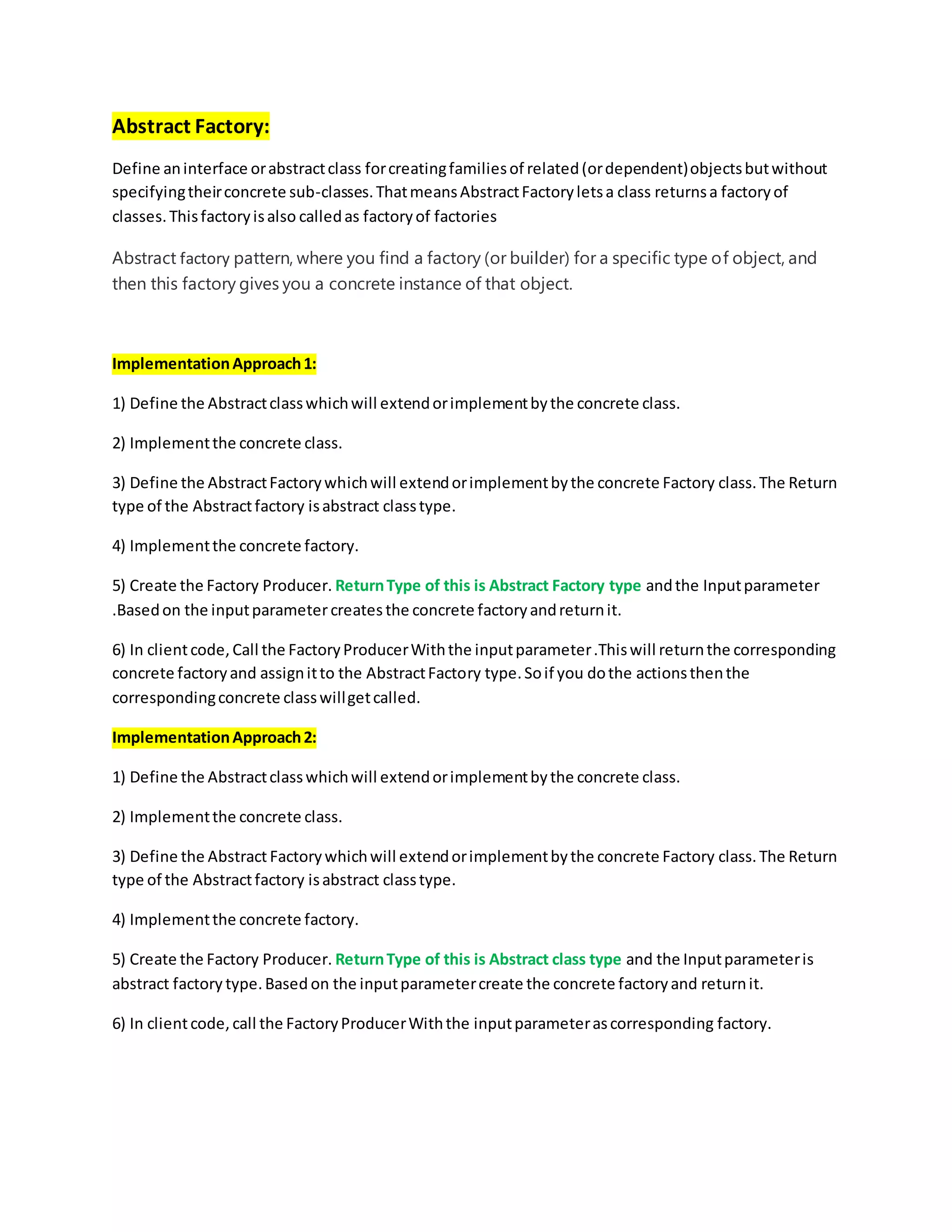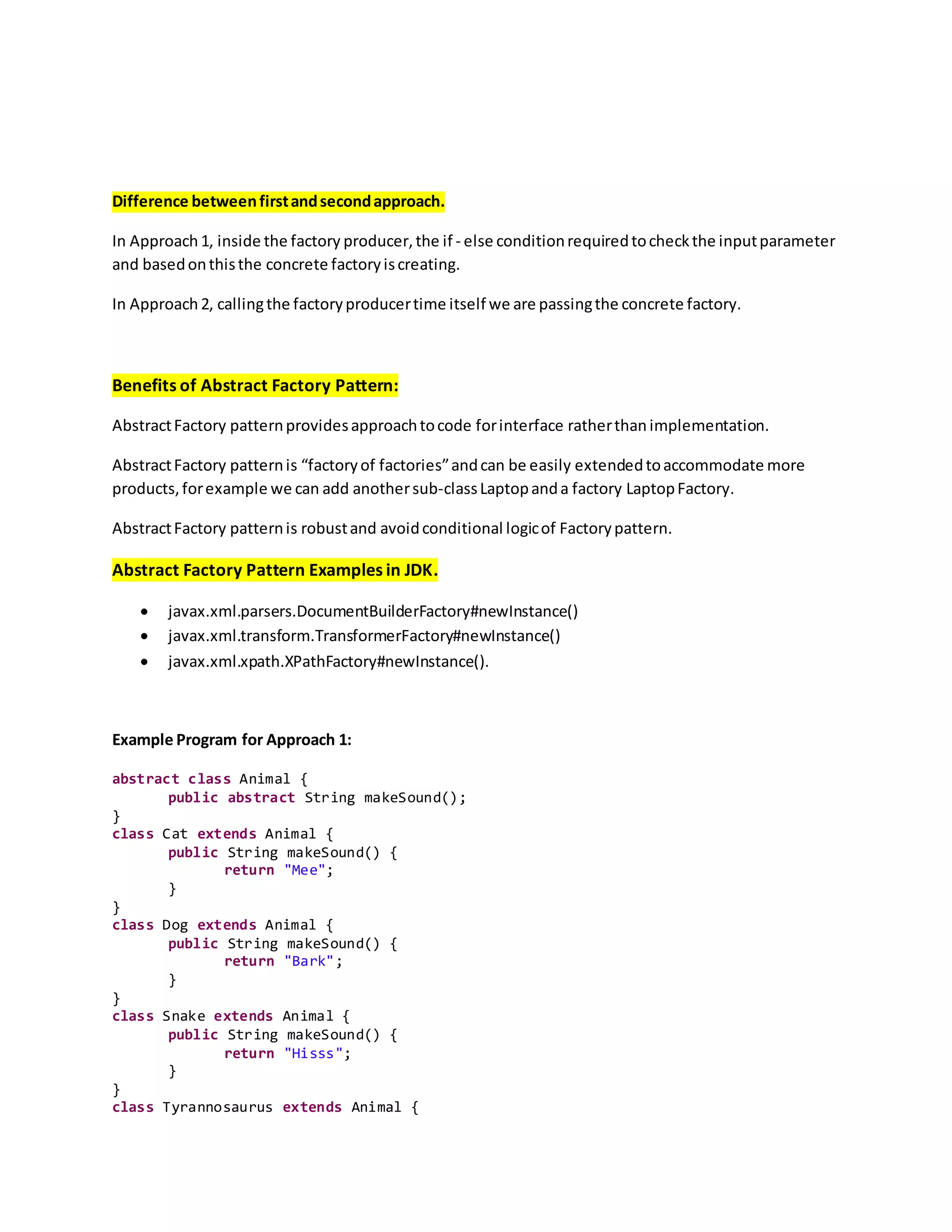The Abstract Factory pattern provides a way to encapsulate a group of individual factories that have a common theme without specifying their concrete classes. It allows a client class to work with families of related product objects independently of their representations. The pattern defines a factory interface for creating products but leaves the concrete product class implementation to the subclasses. There are two common approaches to implementing Abstract Factory - one uses a factory producer that returns the appropriate concrete factory based on a parameter, while the other directly passes the concrete factory. The pattern is useful for decoupling clients from implementations and enforcing constraints on valid class combinations.


![@Override
public String makeSound() {
return "Roar";
}
}
abstract class SpeciesFactory {
public abstract Animal getAnimal(String type);
}
class MammalFactory extends SpeciesFactory {
@Override
public Animal getAnimal(String type) {
if ("dog".equals(type)) {
return new Dog();
} else {
return new Cat();
}
}
}
class ReptileFactory extends SpeciesFactory {
@Override
public Animal getAnimal(String type) {
if ("snake".equals(type)) {
return new Snake();
} else {
return new Tyrannosaurus();
}
}
}
class AbstractFactory {
public SpeciesFactory getSpeciesFactory(String type) {
if ("mammal".equals(type)) {
return new MammalFactory();
} else {
return new ReptileFactory();
}
}
}
public class AbstractFactoryDemo {
public static void main(String[] args) {
AbstractFactory abstractFactory = new AbstractFactory();
SpeciesFactory speciesFactory1 =
abstractFactory.getSpeciesFactory("reptile");
Animal a1 = speciesFactory1.getAnimal("tyrannosaurus");
System.out.println("a1 sound: " + a1.makeSound());
Animal a2 = speciesFactory1.getAnimal("snake");
System.out.println("a2 sound: " + a2.makeSound());](https://image.slidesharecdn.com/abstractfactory-170324162955/75/Abstract-factory-3-2048.jpg)


![@Override
public Computer createComputer() {
return new Server(ram, hdd, cpu);
}
}
class ComputerFactory {
public static Computer getComputer(ComputerAbstractFactory factory) {
return factory.createComputer();
}
}
public class TestDesignPatterns {
public static void main(String[] args) {
Computer pc = ComputerFactory.getComputer(new PCFactory("2 GB", "500
GB", "2.4 GHz"));
Computer server = ComputerFactory.getComputer(new ServerFactory("16 GB",
"1 TB", "2.9 GHz"));
System.out.println("AbstractFactory PC Config::" + pc);
System.out.println("AbstractFactory Server Config::" + server);
}
}
Abstract factory VS Builder Pattern:
Builder provides you more control over the object creation process .
Abstract factory VS Factory Pattern
With the Factory pattern, you produce implementations (Apple, Banana, Cherry, etc.) of a
particular interface -- say, IFruit.
With the Abstract Factory pattern, you produce implementations of a particular Factory interface
-- e.g., IFruitFactory. Each of those knows how to create different kinds of fruit.](https://image.slidesharecdn.com/abstractfactory-170324162955/75/Abstract-factory-6-2048.jpg)
